Giant Honey Bee Apis dorsata Fabricius (Insecta: Hymenoptera: Apidae)
The Featured Creatures collection provides in-depth profiles of insects, nematodes, arachnids and other organisms relevant to Florida. These profiles are intended for the use of interested laypersons with some knowledge of biology as well as academic audiences.
Introduction
The giant honey bee, Apis dorsata Fabricius (Figure 1), has a widespread distribution throughout southern Asia, and is not found in North America. Three subspecies of Apis dorsata are recognized: Apis dorsta dorsata, Apis dorsta binghami, and Apis dorsta breviligula. This species has a different nest design from that of the western honey bee, Apis mellifera L. (https://edis.ifas.ufl.edu/in1005), in that these honey bees build a single, large, exposed comb under tree branches or under cliffs, rather than in cavities. Apis dorsata has developed an effective colony defense system to protect their exposed combs. Professional honey hunters harvest honey seasonally from Apis dorsata colonies in spite of the colony's effective defensiveness and hard-to-reach location high in trees or on cliffs.

Credit: Nikolas Vereecken (Nicolas.vereecken@ulb.ac.be) via Flickr
The nine honey bee species within the genus Apis share many similar morphological, behavioral, and physiological traits. Here we highlight some of the unique characteristics of Apis dorsata and provide some comparisons to those of other honey bee species.
Distribution
Apis dorsata is found throughout the southern countries of Asia, including Malaysia, Indonesia, and the Philippines (Figure 2). The greatest number of Apis dorsata colonies are found in dense forest areas or on cliffs, but nests are occasionally found in urban areas on building ledges (Figure 3).
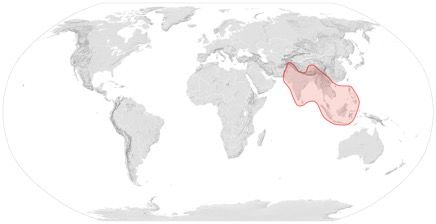
Credit: Sémhur Canuckguy (https://commons.wikimedia.org/wiki/File:Apis_dorsata_distribution_map.svg), via Wikimedia Commons (https://commons.wikimedia.org/wiki/Main_Page)
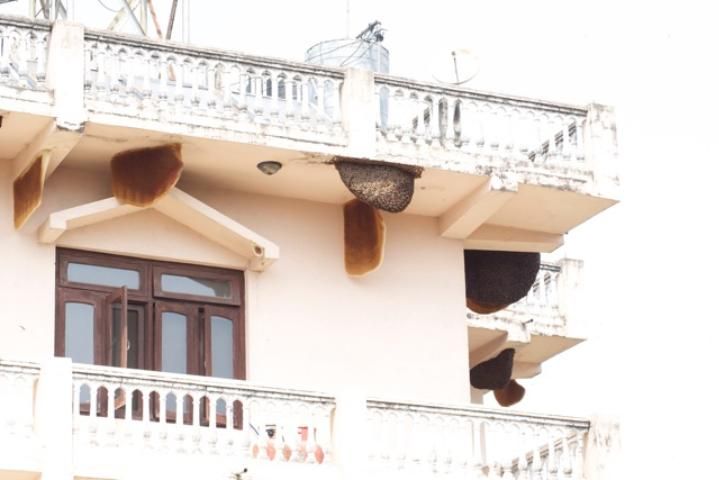
Credit: Simon Croson (sicroson@me.com)
Description
Honey bees are eusocial insects and therefore have overlapping generations, cooperative brood care, and reproductive castes (Mortensen et al. 2015). Each Apis dorsata colony typically contains one queen, several drones and thousands of worker bees. Apis dorsata looks very similar to Apis mellifera, but is larger in size. Apis dorsata workers can measure up to 3 cm (1.2 in) in length, which is almost twice the length of an Apis mellifera worker; thus they are known as the "giant" honey bees. In most honey bee species, the reproductive bees (queens and drones) are larger than the workers; however, there is very little difference in body size between the reproductive bees and workers in Apis dorsata.
The queen lays all of the eggs for the colony and is usually the mother of all of the workers and drones within the colony. She is the sole reproductive female in the colony and has a larger abdomen as her reproductive organs are more developed (Figure 4). The queens are usually darker than are the workers.
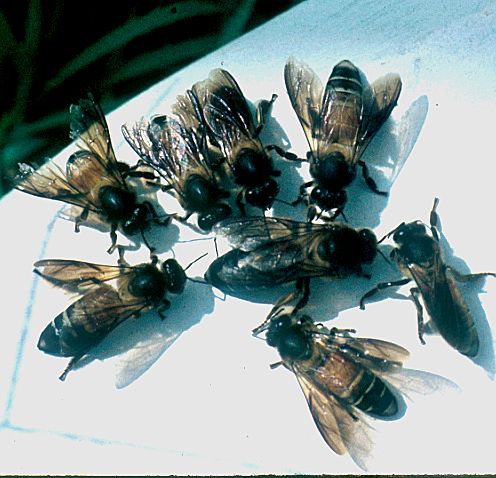
Credit: Nikolaus Koeniger (nikolaus.koeniger@zoologie.uni-halle.de), Martin–Luther-Universität, Institut für Biologie, Bereich Zoologie
The male honey bees are called drones and are easily identifiable because they have large eyes, short, round abdomens, and lack a stinger (Figure 5). Drones are only produced during the reproductive season and leave their home colony to mate with queens from other colonies. Each colony will produce more than a thousand drones seasonally.
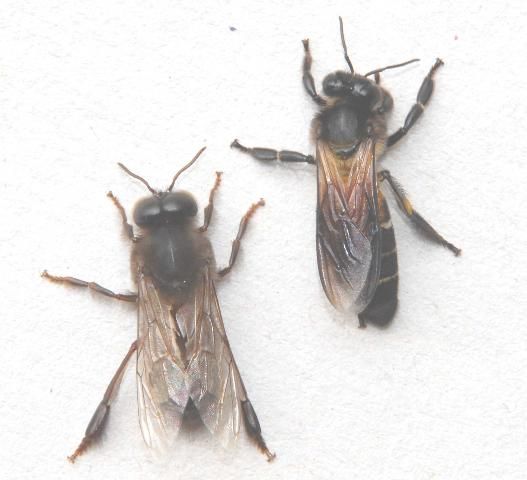
Credit: Nikolaus Koeniger (nikolaus.koeniger@zoologie.uni-halle.de), Martin–Luther-Universität, Institut für Biologie, Bereich Zoologie
Adult workers have a relatively short life span (about two months). Just as in other honey bee species, the adult workers have a corbiculum (pollen basket) on their hind tibia (section of leg) and plumose (branched) body hairs that aid in pollen collection. The adult workers have a modified ovipositor that is used as a stinger. When a bee stings, its stinger remains embedded in the perceived threat and is torn away from its abdomen, thus killing the bee. Workers perform all other colony tasks such as foraging for nectar and pollen, producing honey, tending the brood (eggs, larvae, and pupae), and protecting the nest from predators.
Life Cycle
The life cycle and life stages of Apis dorsata are the same as those in all other honey bee species (see and the life cycles of Apis mellifera and Apis cerana). Honey bees are holometabolous insects, which means they undergo four separate life stages (egg, larva, pupa, and adult).
Egg
A queen will lay one egg in an individual wax cell at a time. Eggs are small, white, and oval; they look similar to a grain of rice. After three days, a larva will hatch from the egg.
Larva
The larvae are small, white, and maggot-like. They remain in their individual cells. They are fed a steady diet of a protein-based liquid produced by younger adult workers. For six days, the larvae will eat until their body weight attains that of a fully developed adult. They are usually found lying in the bottom of a wax cell in the shape of a letter C.
Pupa
Once the larvae are ready to pupate, the workers cover the cell with a wax capping. The pupa will remain undisturbed for 12 days.
Adult
After completing the final molt and eclosing from the pupal casing, the adult bee will exit the cell by chewing through the wax capping.
All honey bee species are superorganisms in that whole colonies, rather than individual bees, are considered to be the biological unit. One colony can split into two colonies once the colony becomes large in size and there are abundant food resources (nectar and pollen). This colony-level reproduction is known as swarming (DeBerry et al. 2012).
The lifespan of Apis dorsata workers is not well characterized. Compared to Apis mellifera, Apis dorsata workers seem to live significantly longer, especially during migration swarms when workers will sometimes travel more than two months to reach a new destination and produce a new generation of bees (Koeniger et al. 2010).
Biology
Apis dorsata builds open nests that hang from under thick tree branches or under cliffs (Figure 6). They build a single large comb up to 150 cm in length and 70 cm tall (Figure 7). The comb is permanently covered by a curtain of up to 100,000 worker bees (Figure 8). This curtain is several layers of bees thick and forms a protective barrier separating the vulnerable brood from the environment. This protective curtain is sufficient to protect the nest during storms with heavy wind and rain.
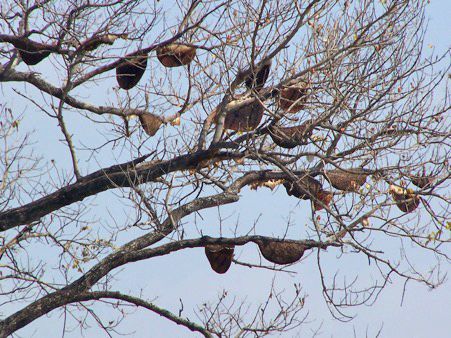
Credit: Rajesh Dangi (https://commons.wikimedia.org/wiki/File:Honeycomb_on_tree.jpg) via Wikimedia Commons (https://commons.wikimedia.org/wiki/Main_Page)

Credit: Nikolaus Koeniger (nikolaus.koeniger@zoologie.uni-halle.de), Martin–Luther-Universität, Institut für Biologie, Bereich Zoologie
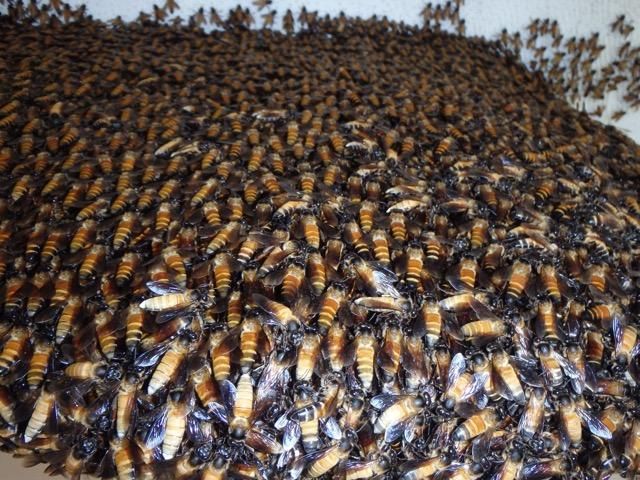
Credit: Simon Croson (sicroson@me.com)
The large body size of Apis dorsata allows increased flight distance and foraging range compared to other honey bee species. Apis dorsata colonies can perform seasonal long-distance migrations in order to exploit the nectar and pollen resources available at different times throughout many parts of southern Asia (Oldroyd et al. 2000). The colony leaves behind an empty comb when it departs from a nest site. Interestingly, the same colony has been observed to return to the exact same branch six months later, even though the bees that inhabited the old nesting location would have died long before.
There are only minor differences in the three sub-species of Apis dorsata. Apis dorsata dorsata is the most widespread subspecies in southeast Asia, while Apis dorsata breviligula and Apis dorsata binghami are only found in specific locations. Apis dorsata breviligula is different from Apis dorsata dorsata in that it has white abdominal stripes and a shorter tongue and is only found in the Philippines. Apis dorsata binghami also differs slightly from Apis dorsata dorsata in that it has a longer tongue and wings and is only found on Sulawesi, an island of Indonesia.
Apis dorsata has been described as one of the most dangerous animals of the southeastern Asian jungles due to their threatening defensive behaviors. It is considered the most defensive of all of the honey bees, even more defensive than the African honey bee (Ellis and Ellis 2009; Hall et al. 1995). Their main weapons are stingers that are up to 3 mm long and easily penetrate clothing and even the fur of a bear. Attached to the stingers are large venom glands with accompanying muscles that pump the venom into the skin, thus delivering a painful sting. Large numbers of Apis dorsata attack a perceived threat, though only a few provide the painful stings because the bees will die shortly after stinging. The other bees will buzz loudly and bite the threat to deter the threat, without risking the life of many individuals.
These bees have evolved a unique method of defense to deter predators from attacking their exposed nests. An alarmed guard bee will fly back to the nest and, with an exposed stinger, run in a zigzag pattern along the curtain of bees. The bees will then run to the lower rim of the comb and create large thin chains of bees (Figure 9) while making a hissing sound. This act not only prepares the guard bees for attack, but also makes the nest look larger than it is. This defense is particularly useful against bird predators that try to rip sections of brood from the comb, because the birds often attack the bottom of the comb, grabbing only handfuls of bees.
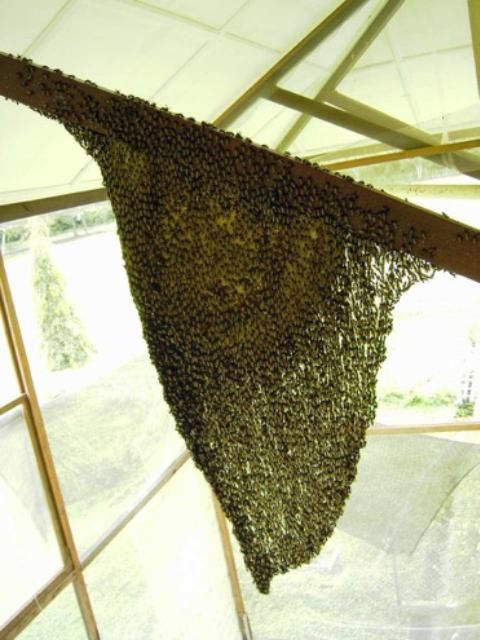
Credit: Nikolaus Koeniger (nikolaus.koeniger@zoologie.uni-halle.de), Martin–Luther-Universität, Institut für Biologie, Bereich Zoologie
Apis dorsata uses another fascinating method of defense known as shimmering. Shimmering involves a display of waves which moves across the surface of the nest in a fraction of a second as the bees raise their abdomens in a sequential order. These waves originate from individual bees which perceive a predator and raise their abdomen first, invoking a similar response from the surrounding bees. The visual display of shimmering is thought to intimidate potential threats such as predatory wasps, birds, and mammals.
Economic Impact
Apis dorsata is considered to be extremely important to both honey gatherers/hunters and agricultural producers in southern Asia. Unlike Apis mellifera and Apis cerana, Apis dorsata colonies cannot be transported for pollination purposes; therefore, locals are mainly interested in harvesting honey from colonies.
There is much to gain for locals willing to risk harvesting honey from these colonies because Apis dorsata colonies are so large and such efficient honey producers. Some of the larger colonies can contain up to 15 kg (33 lbs.) of honey. In addition to honey, the wax and bee brood are also sold at a significant price.
Although the bees are not managed for pollination, many crops throughout southern Asia depend upon Apis dorsata. Some of the major crops thought to be heavily dependent upon Apis dorsata pollination include cotton, mango, coconut, coffee, pepper, star fruit, and macadamia. Currently, there are no reliable estimates on the actual economic contribution of Apis dorsata pollination.
Apis dorsata is also the natural host of the Tropilaelaps mite (https://edis.ifas.ufl.edu/in1061), a devastating parasite with an expanding distribution. Apis mellifera is not a natural host of Tropilaelaps, but can be parasitized by the mite in areas where both Apis dorsata and Apis mellifera are present. This poses a significant threat to beekeepers world-wide, as Tropilaelaps can increase colony losses, negatively affecting the commercial beekeeping industry (Mortensen et al. 2014).
Management
Apis dorsata is not managed like other honey bee species because they are an open-nesting species. Attempts to place Apis dorsata colonies in wooden Langstroth hives traditionally used for Apis mellifera and Apis cerana have all failed (Koeniger et al., 2010), as these bees have not evolved to live in dark cavities. Instead of beekeeping to obtain honey, wax and brood, honey gathering from feral Apis dorsata colonies is the common practice in many regions of the bee's distribution.
For centuries, people throughout southern Asia have gone through great risk to harvest honey from Apis dorsata colonies. Aggregations of Apis dorsata colonies are usually in the tallest trees/cliffs, thus presenting a major challenge to access. Furthermore, the natural distribution of these bees overlaps with that of tigers, which have been known to kill honey hunters. Traditional honey gathering is usually done on a moonless night to minimize the number of flying bees once the colony is disturbed. Either ropes or makeshift ladders are used to reach the top of the trees/cliffs and a flame is used to knock the bees off of the comb. Often times honey hunters harvest the whole nest to obtain both the honey and the brood; however, recent conservation efforts are pushing honey gatherers to just cut away the sections of honey comb (Figure 10) instead of destroying the whole colony.

Credit: Tim Laman (tim@timlaman.com) via www.timlaman.com
Rafter beekeeping is practiced in certain regions of Vietnam, Cambodia and Indonesia with submerged forests. A tikung (Figure 11) is a carved plank of wood under which Apis dorsata swarms build nests. Tikung planks are notched at both ends in order to attach the plank to sturdy branches a few feet above the waters surface. Similar to traditional honey gathering in bee trees, collecting honey from tikung nests is done on moonless nights and the bees are brushed away with a torch. The tikungs are approached by gatherers in small boats and the honey comb is cut with a wooden knife, as an iron knife is traditionally thought to deter future swarms from using that tikung. The average honey yield per tikung is about 6-10 kg. These tikung planks are only attractive in areas with low vegetation as Apis dorsata colonies usually prefer tall trees.
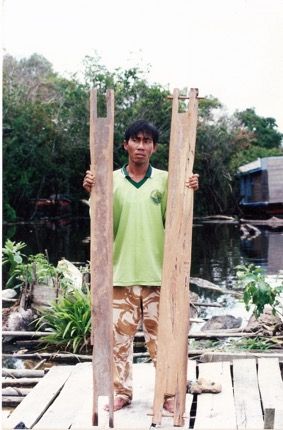
Credit: Dr. Soesilawati Hadisoesilo, used with permission from Nikolaus Koeniger (nikolaus.koeniger@zoologie.uni-halle.de), Martin–Luther-Universität, Institut für Biologie, Bereich Zoologie
Selected References
Batra SWT. 1997. "Fruit-pollinating bees of the Garhwal Himalaya, U.P., India." Acta Horticulture 437: 325–328.
Cao LF, Zheng HQ, Hu CY, He SY, Kuang HO, Hu FL. 2012. "Phylogeography of Apis dorsata (Hymenoptera: Apidea) from China and neighboring Asian areas." Annals of the Entomological Society of America 105: 298–304.
DeBerry S, Crowly J, Ellis, JD. 2012. Swarm Control for Managed Beehives. ENY-160. Gainesville: University of Florida Institute of Food and Agricultural Sciences. https://edis.ifas.ufl.edu/in970 (February 2016)
Ellis JD, Ellis A. 2009. African Honey Bee, Africanized Honey Bee, Killer Bee, Apis mellifera scutellata Lepeletier (Insecta: Hymenoptera: Apidae). ENY 429. Gainesville: University of Florida Institute of Food and Agricultural Sciences. (8 December 2015)
Hepburn R, Radloff SE. 2011. Honeybees of Asia. Springer, Verlag, Berlin, Heidelberg.
Kastberger G, Weihmann F, Hoetzl T, Weiss SE, Maurer M, Kranner I. (2012). How to join a wave: Decision-making processes in shimmering behavior of giant honeybees (Apis dorsata). PLoS ONE 7: e36736. doi:10.1371/journal.pone.0036736.
Koeniger N, Koeniger G, Tingek S. 2010. Honey Bees of Borneo: Exploring the Centre of Apis Diversity. Natural History Publications (Borneo), Kota Kinabalu, Sabah, Malaysia.
Mortensen AN, Burleson S, Chelliah G, Johnson K, Schmehl DR, Ellis JD. 2014. Tropilaelaps mite Tropilaelaps spp. Delfinado & Baker (Arachnida: Mesostigmata: Laelapidae). EENY604. Gainesville: University of Florida Institute of Food and Agricultural Sciences. https://edis.ifas.ufl.edu/in1061 (2 December 2015).
Mortensen AN, Smith B, Ellis JD. 2015. The Social Organization of Honey Bees. ENY-166. Gainesville: University of Florida Institute of Food and Agricultural Sciences. https://edis.ifas.ufl.edu/in1102 (2 December 2015)
Oldroyd BP, Osborne KE, Mardan M. 2000. "Colony relatedness in aggregations of Apis dorsata Fabricius (Hymenoptera, Apidae)." Insects Sociaux 47: 94–95.
Paar J, Oldroyd BP, Huettinger E, Kastberger G. 2004. "Genetic structure of an Apis dorsata population: the significance of migration and colony aggregation." Journal of Heredity 95: 119–126.
Robinson WS. 2012. Migrating giant honey bees (Apis dorsata) congregate annually at stopover site in Thailand. PLoS ONE 7: e44976. doi:10.1371/journal.pone.0044976.
Wright J. "Pollination by honeybees in the Philippines" 06 Dec. 2014. www.beephilippines.info (23 October 2014).



